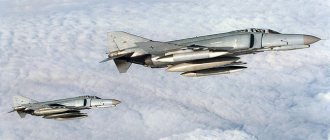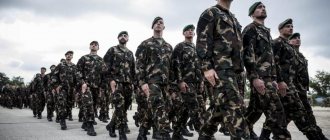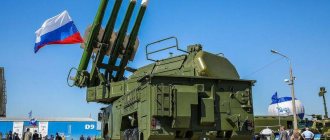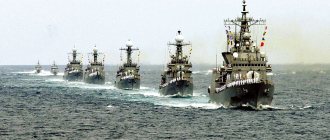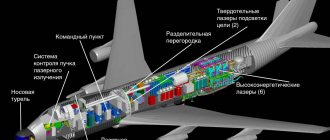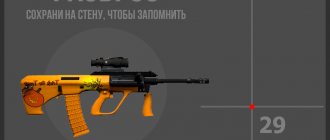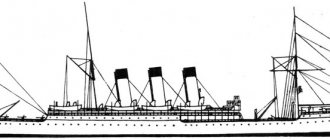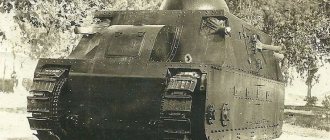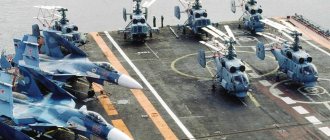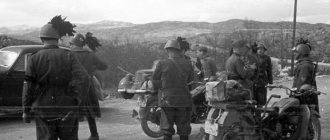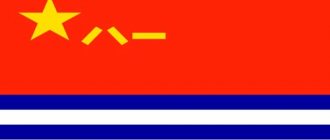| Flag of the Italian Navy |
The Navy of the Italian Republic is one of the branches of the armed forces of this country. In accordance with Italian military doctrine, the country's naval forces are assigned two main tasks - protecting national interests and participating in ensuring international security in close cooperation with NATO allies. In addition, they perform a number of secondary functions, such as monitoring navigation in the strait zone, illegal maritime transport, illegal immigration, as well as combating piracy and conducting search and rescue operations on the high seas.
The current Italian naval strategy provides for the possibility of the presence of the national navy not only in the Mediterranean Sea, but also in remote regions of the world, including the Black and Red Seas, and the Indian Ocean.
Taking into account the situation in the Mediterranean region due to the aggravation of the situation in the countries of North Africa and the Middle East, the role of the national navy in ensuring the protection of state interests has increased even more.
Story
The Italian army arose in 1861 - simultaneously with the unification into the Italian Kingdom of the independent Italian states of the Apennine Peninsula that existed at that time: Sardinia, the Kingdoms of Naples and Sicily, Lombardy, the Grand Duchy of Tuscany, the Duchies of Parma and Modena. Since its creation, the army has actively participated in military operations, including colonial and two world wars, local conflicts and invasions. She played a significant role in the division of Africa (1885-1914) and the formation of colonial states. To protect the conquered territories, colonial troops appeared in the Italian army, recruited mainly from aborigines - residents of Eritrea and Somalia; by 1940 the number reached 256,000.
When the country joined NATO, its armed forces began to take part in operations carried out by the Alliance. Among them: “Allied Force” (a series of air strikes on the territory of the former Yugoslavia), “Resolute Support” (providing assistance to the Afghan government), “Allied Defender” (NATO intervention in the civil war in Libya).
Building up Italy's military power has become a priority since the early 20s of the 20th century: Italians were called up for military service for a year and a half instead of 8 months. Benito Mussolini's rise to power in 1922 led to the popularization of fascism in the country. The result of the foreign policy pursued by the Duce, the stated goal of which was the restoration of the Holy Roman Empire, was the conclusion of a military alliance with Nazi Germany. So the Italian army became involved in hostilities, and later itself initiated a war - with France and Great Britain. During World War II, the development of the Italian army accelerated.
Despite the fact that the result of the aggression was the loss of colonies and capitulation in 1943, participation in the war brought Italy “dividends”: a powerful fleet, including several dozen submarines and almost two hundred warships.
In the mid-20th century, the development of Italy's military-industrial complex continued; this became possible thanks to the country's accession to NATO in 1949. Today, Italy’s military potential is significant: it has a lot of military equipment of its own production: tanks created on the basis of the German Leopards, military aircraft (fighters, attack aircraft, transport aircraft, etc.) and helicopters, mountain howitzers, anti-aircraft guns, as well as small arms (automatic rifles, pistols, machine guns, etc.). At the same time, the level of combat training of soldiers and officers is considered low. At the beginning of the last century, the Italian army repeatedly suffered defeats on military fronts (significant losses in clashes with Austria, complete defeat by Austro-German troops in 1917, colossal losses in North Africa), but this did not greatly affect the improvement of the professional qualities of the soldiers of the Italian armed forces strength in the future.
DEVELOPMENT PROSPECTS OF THE ITALIAN NAVY
The country's leadership pays considerable attention to the development of the national naval forces. In order to maintain the constant readiness of the fleet to carry out the tasks facing it, including within the framework of existing obligations to NATO and the European Union, the command is currently implementing a set of measures to increase the combat capabilities of the Navy. It provides for the improvement of the management system and organizational structure, optimization of the number and combat strength, phased modernization and replacement of outdated ships and weapons, as well as the development of a basing and logistics support system for fleet forces.
Frigate URO F 590 "Carlo Bergamini", created as part of the FREMM program |
As part of the national naval reform program, designed until 2032, the main goals and directions of their activities for the next decade (until 2024) were formulated. At the same time, as the main requirements for the future structure of the fleet. the formation of a flexible control system, the achievement of universality in the use of forces and means, as well as the creation of an optimal maintenance structure are determined.
Thus, in the interests of improving the command structure of the Navy, by the end of 2014 it is planned to reorganize the submarine division into the General Staff flotilla, disband the 53rd and 54th minesweeper divisions and integrate the ships included in them into a group under a single command.
In order to create a more compact and efficient fleet maintenance system, the Italian Navy command plans to complete the formation of a new logistics structure at the beginning of 2015. It will include the logistics command (Naples) with four subordinate territorial logistics commands (TC) - “Capital” (Rome), “North” (Naval Base La Spezia), “South” (GVMB Taranto) and “Sicily” (NAB Augusta) . It is planned to create territorial TCs (except for Stolichny) based on the existing infrastructure of the WMO and autonomous naval commands, which will subsequently be abolished. In addition, it is planned to create a command of educational institutions (Ancona), which will take over the functions of the corresponding inspectorate.
As part of the ongoing reforms, it is also planned to improve the fleet basing system by concentrating the naval personnel mainly at three naval bases - Taranto Naval Base, Spezia Naval Base and Augusta, and naval aviation at the air bases of Grottaglie, Luni and Fontanarossa.
Currently, the average service life of Italian warships of the main classes is about 30 years. In this regard, the Navy command is forced to replace most of the outdated ships.
Thus, it is planned to withdraw more than 20 warships of various classes from the fleet by 2022, including: the light aircraft carrier J. Garibaldi" (put into service in 1985), seven Maestrale-class frigates (1982-1984), six Minerva-class corvettes (1987-1990), three Lerici-class minesweepers (1985) and two submarines type "Sauro" (1988-1989). At the same time, in order to obtain additional funds for the modernization of the fleet, it is planned to sell part of the ships removed from the Navy to third countries.
Structure
The Italian army includes ground, naval and air forces. Since 2001, another type of troops has been added to them - the carabinieri. Total number of personnel: about 150,000 people.
Ground troops
The ground forces are formed from several divisions and brigades: mountain infantry, armored, etc. There are parachute and cavalry brigades, signalmen, and air defense troops. The Bersaglieri, or riflemen, deserve special mention - a special branch of the army, the elite infantry, distinguished by high mobility. Since 2005, only professional soldiers and volunteers have been accepted into the infantry forces of the Italian Army.
It is armed with Italian tanks and other armored vehicles; artillery and air defense systems - mainly foreign-made; more than 300 helicopters, a fifth of them are combat helicopters. There are more than 550 old German tanks in storage.
Fleet
The Italian fleet has traditionally, since the beginning of World War II, been ahead of other types of the country's armed forces in terms of development . Its potential, including production, scientific and technical, is very great; All combat vessels used are built in our own shipyards. These include the latest submarines, destroyers and unique aircraft carriers equipped with air defense systems and anti-ship missiles.
Air Force
It is officially believed that the national aviation of Italy arose in 1923. However, at the beginning of the century, Italy used aircraft in the war with Turkey, becoming the first country in the world to use them for combat operations. Italian pilots took part in the Spanish Civil War, the war with Ethiopia, and the First World War. By the beginning of World War II, the Italian army had more than 3,000 aircraft in service. Nowadays, their number has decreased significantly, but continues to be quite impressive.
Carabinieri
Carabinieri troops recently became part of the Italian army. They have double subordination - to the Ministry of Defense and the Ministry of Internal Affairs, since the carabinieri also perform police functions.
The carabinieri units include helicopter pilots, divers, dog handlers, and orderlies; a special task force whose responsibilities include the fight against organized crime.
The Carabinieri are distinguished by better training - combat and psychological - than representatives of other types of troops.
History of camouflage: Italian fleet
Like most naval powers, the Royal Italian Navy (Regia Marina) did not pay much attention to the camouflage painting of warships during the interwar period. The Second World War made its own adjustments: ships had to be protected from enemy attacks, and for this it was necessary to make it as difficult as possible for the enemy to determine the type of ship, its course and speed. Our colleagues from the portal worldofwarships.ru tell us how the Italians coped with this task.
By the beginning of World War II, Italian ships were painted according to the standard adopted in 1929. In accordance with it, the surface of the hull and vertical surfaces were required to be painted in a light ash-gray color (Grigio Cenerino). The underwater hulls of large ships were painted dark green (Verde Scuro), while those of destroyers were painted brick red (Rosso Mattone). The metal parts of the decks were dark gray with a metallic sheen (Grigio Ferro), and the wooden covering of the decks remained unpainted. The waterline, the top part of the mainmast and the canopies on the chimneys were black.
With the outbreak of hostilities, the picture began to change. After Italian aircraft mistakenly began bombing their own ships in the battle of Calabria in July 1940, a decision was made to apply identification marks. To make it easier to identify their warships from the air, alternating red and white stripes were applied to the forecastle or quarterdeck of all ships. The upper surfaces of ship's seaplanes were painted in the same way.
The identification zone on destroyers was located up to the bow breakwater, and on larger ships - up to the bow tower. The exception was the Littorio class battleships. Here, each of the battleships had its own characteristics. On the Littorio and Vittorio Veneto, the identification stripes ended before reaching the bow tower, while on the Vittorio Veneto, the wooden poop deck was painted over with lead-gray paint with diagonal stripes applied to it. Littorio received this coloring in the stern much later - at the end of 1941. On the battleship Roma, the identification paint on the bow extended to the second breakwater, but the stern was not painted at all. On the Littorio and Vittorio Veneto, the identification stripes were painted over in early 1943, unlike the Roma, which wore them until its death in September 1943.
The light gray color of the Italian peacetime ships, hardly noticeable in cloudy weather, seemed almost white in clear and sunny weather and was clearly visible from afar. Therefore, in 1940, work began on creating camouflage patterns. On January 18, 1941, the Ministry of the Navy issued a decree on the introduction of camouflage colors for warships.
The first experiments were carried out on the cruisers Fiume and Emanuele Filiberto Duca d'Aosta, which were at that time being repaired in La Spezia. On January 21, two samples of experimental camouflage patterns, developed based on the coloring of the First World War, arrived from the ministry. Duca d'Aosta was painted with bright yellow-green diverging wedges, which were supposed to make it difficult for enemy observers to determine the elements of the ship's movement. The hull itself and its superstructures were painted a deep dark gray - this scheme was called “double fishbone”. Subsequently, this type of camouflage was recognized as ineffective, and all ships that had it were repainted. The scheme used on Fiume - dark vertical stripes along the hull and superstructures - turned out to be more successful. Gorizia, the only ship in the series to survive the battle of Cape Matapan (1941), received the Claudus camouflage paint scheme in March 1942, introduced by order of February 15 and named after the marine painter who designed it. It had a rather complex pattern with jagged edges. The colors used were dark grey, light grey, and off-white (Bianco Sporco Opaco), but in the summer the white areas were painted over with light grey. The camouflage remained until the end of the war, as can be seen from photographs of the sunken ship taken in 1945 in La Spezia. Trento in April 1942 was also painted according to the Claudus scheme, but this cruiser used black instead of dark gray.
In October 1941, a new two-color scheme was tested. The main color remained light ash gray (Grigio Cenerino), and wide dark gray stripes were applied to it. The ends were painted an off-white color to mask the size of the waves the ship raised and thereby make it difficult to determine its speed.
On December 29, 1941, this scheme was officially approved as standard. At the same time, it was recommended, if possible, to apply different designs both to different ships and to different sides of the same ship. Dark stripes should be given an irregular shape, avoiding horizontal, vertical or parallel lines. During 1942, this scheme was introduced everywhere with the exception of a few ships already painted according to the Claudus scheme. Trieste in June 1942 received a similar scheme, but with separate light green areas, including the extremities. In July, the light green areas were repainted off-white, and by the end of August - ash gray.
Another Claudus scheme became quite popular in the initial period of the war - a combined fragmentation painting made on the basis of broken polygons of two contrasting shades of gray. In some cases, one or two colors could be added to the hull, ends and superstructures - most often light blue (Azzurro) and off-white.
A similar coloring, but in three colors, was used on a different scheme with smooth rounded stripes. If in the previous camouflage light colors could be applied to any part of the ship, then in this scheme only the extremities were highlighted with light tones. We can say that in this case the false perspective method was used, similar to the camouflage of Kriegsmarine ships.
Bolzano, during repairs in Genoa at the beginning of 1942, for some time wore camouflage, which made it difficult to detect from the air, and before returning to service it was repainted according to the standard scheme. As on other cruisers, the off-white areas were repainted ash gray by the end of August 1942.
The camouflage pattern varied both between cruisers and between the left and right sides of the same ship. All vertical surfaces were camouflaged: sides, superstructures, pipes and towers. The main purpose of camouflage was to make it difficult to determine the type of ship, its course and speed. These measures seemed important to the Italians, among other things, to reduce the threat posed by British submarines actively operating in the Mediterranean. However, the camouflage coloring did not protect either the Trento or the Bolzano from being hit by torpedoes from British submarines, so this measure cannot be called effective.
After Italy defected to the Allies, the camouflage paint scheme was abolished, and the Italian ships were repainted according to the standard scheme used on Allied ships: a dark gray hull and light gray superstructures.
Klim Zhukov
/
Raid on Taranto
Triumphant raid of British carrier-based aircraft on the base of the Italian fleet on November 11, 1940
- WWII
- fleet
- aviation
Sergey Marchenko
/
Battle of Cape Passero
On the night of October 12, 1940, a naval battle took place off the coast of Sicily, which had far-reaching consequences for the Italian fleet.
- WWII
- fleet
- Great Britain
- Italy
Sergey Marchenko
/
From heroes to criminals and back
“The behavior of the officers and crews was excellent...”: the death of the Italian-German convoy “Drossel” on November 24, 1941
- WWII
- fleet
- Great Britain
- Italy
Uniform and ranks
Unlike Russia, where only two types of military ranks are established - military and naval, in the Italian army each type of military has its own ranks. The exception is the ranks of the air force: they almost completely correspond to the names adopted for the ground forces. The main differences: the absence of the rank of major general in the Air Force (literally translated from Italian - “brigadier general”). There are also peculiarities in the designation of senior army ranks: in the ground forces the term generale is used, in aviation - comandante.
The rank of "corporal" (between private and corporal) exists only in the ground forces. There are no corporals or corporals in the fleet, only sailors and junior specialists (corresponding to the rank of senior corporal in other branches of the military). Russian petty officers and warrant officers correspond to sergeant majors.
The rank of junior officers is represented by three ranks. The captain of the ground forces and the captain of the gendarmerie correspond to the squadron commander and the naval lieutenant commander. There is no rank of “lieutenant” in the navy; in the navy it is replaced by “midshipman”. There are also three senior ranks.
It is curious that naval ranks contain the names of types of ships: for example, the rank of “captain of the 3rd rank” literally sounds like “corvette captain,” and a higher rank is “frigate captain.”
The most original names are those of the carabinieri, or gendarmes; This is exactly how it is customary to translate the Italian carabiniere into Russian. Only junior and senior officers of the gendarmerie and ground forces bear the same ranks. In addition, the Carabinieri lack two out of five general ranks. There are only three higher ranks: the inspector general of the district, the second commander (or acting general) and the general.
Like all armies in the world, the Italian uses camouflage uniforms for field operations. The Italian military acquired its own colors in 1992; before that, designs developed for the US Department of Defense were used. Among the standard equipment, it is worth noting a camouflage poncho with a hood, which, if necessary, can be used as an awning. It is equipped with a warm lining, also dual-purpose, since it can serve as a blanket.
In cold weather, Italian military personnel may wear wool turtleneck sweaters with a zipper.
As for shoes, lightweight boots for wearing in hot climates deserve special mention . Their lower part, the boot itself, is made of durable leather; high top – soft, made of fabric and suede. Special eyelet openings serve for ventilation. Additional protection against sand or small stones getting into your boots is provided by nylon gaiters, which are worn over trousers and shoes.
The dress uniform partially contains accessories left over from earlier times; So, for the Carabinieri these are cocked hats with a plume. Almost every unit wears its own variety of uniform, which also differs depending on the status of the special event. For example, only soldiers of the Sardinian mechanized grenadier brigade, created in 1831, wear tall fur hats, similar to those worn by English guards, to participate in parades.
Status and development prospects of the Italian Navy (2014)
Colonel V. Khoprov
The Italian leadership views the country's Navy as one of the main instruments guaranteeing the protection of national and coalition interests. At the same time, in order to adequately respond to new challenges and threats, it is considered vitally important to ensure the presence of the Italian Navy not only in the Mediterranean Sea, but also in remote regions of the world, including the Black and Red Seas, and the Indian Ocean.
Taking into account the situation in the Mediterranean region due to the aggravation of the situation in the countries of North Africa and the Middle East, according to the country's leadership, the role of the national navy in ensuring the protection of state interests has increased even more.
Currently, the Italian naval forces organizationally include the fleet, autonomous naval commands, naval districts and the command of combat swimmers and saboteurs. Their general management is carried out by the Chief of the Main Staff of the Navy. Subordinate to him is the main command of the coast guard, which in peacetime is connected to the Ministry of Infrastructure and Transport, and also acts in the interests of a number of other relevant ministries of the country. Direct leadership of naval formations and units is entrusted to the fleet commander.
| Location of the main naval bases of the Italian Navy |
| Organizational structure of the Italian Navy |
| Prospective organizational structure of the Italian Navy |
The fleet (headquarters in Santa Rosa, Rome) includes six commands: main (Taranto), submarine (Santa Rosa, Rome), patrol (Augusta), minesweeping and auxiliary (Spezia), landing (Brindisi) forces, naval aviation (Santa Rosa, Rome), as well as the naval training center (Taranto).
The command of the main forces is subordinate to two divisions of frigates (10 FR and two universal supply transports), two light aircraft carriers, four guided missile destroyers (of which two are Andrea Doria type), three guided missile frigates (Carlo Bergamini type), three landing -helicopter dock ship (DVKD) and reconnaissance ship. In addition, this structure includes the command of the task force. It is intended to manage dedicated forces and assets (ship formations) formed to perform specific tasks as part of permanent NATO Allied Forces formations and multinational naval formations of European states, as well as the Italian-Spanish amphibious assault force. Light aircraft carriers (G. Garibaldi and Conte da Cavour), the San Giusto airborne assault ship and the Etna universal supply transport can be used as headquarters ships.
The submarine forces command includes a submarine division (six submarines) and a training school for submarine specialists.
Subordinate to the command of the patrol forces is a division of corvettes (six units) and two divisions of patrol ships (the Cassiopeia and Comandante types; 10 in total).
The command of mine-sweeping and auxiliary forces includes two divisions of minesweepers (10 units) and a group of ships of auxiliary forces.
The command of the amphibious forces includes the San Marco Marine Brigade (MP) with a total strength of about 3,500 people (three MP regiments and a landing boat division), as well as an interspecific amphibious forces training center.
The Naval Aviation Command has three air bases, which are home to one squadron of carrier-based AV-8B Harrier aircraft, five anti-submarine helicopters and a landing operations support group.
Basic patrol aircraft of the Navy (Atlantic aircraft) are organizationally part of the Air Force, and on issues of operational use they report directly to the fleet commander.
The command of combat swimmers and saboteurs "Teseo Theseus" reports directly to the chief of the main headquarters of the Navy. It includes a detachment of combat swimmers and saboteurs, as well as a group of support ships.
The coast of the continental part of Italy and the islands with coastal waters is divided into three naval districts - Tyrrhenian, Ionian, Adriatic and three autonomous naval commands - Capital, on the islands of Sicily and Sardinia.
In total, the Italian Navy has 55 warships, 40 boats (including 34 landing craft), 17 AV/TAV-8B Harrier carrier-based aircraft, 49 helicopters (22 EN-101, 22 A1-212, two SH- 3D, three SH-90) and six Atlantic UUV aircraft.
In addition, the fleet has more than 90 auxiliary vessels, including three universal supply transports, six support vessels (reconnaissance, experimental, research, two hydrographic and one rescue), six transports, seven tankers, about 40 ocean-going and offshore tugs, two training sailing ships, etc.
In accordance with doctrinal guidelines, the Italian Navy is assigned two main tasks - protecting national interests and participating in ensuring international security in close cooperation with NATO allies. In addition, they perform a number of secondary functions, such as monitoring navigation in the strait zone, illegal maritime transport, illegal immigration, as well as combating piracy and conducting search and rescue operations on the high seas.
The country's leadership pays considerable attention to the development of the national naval forces. In order to maintain the constant readiness of the fleet to carry out the tasks facing it, including within the framework of existing obligations to NATO and the European Union, the command is currently implementing a set of measures to increase the combat capabilities of the Navy. It provides for the improvement of the management system and organizational structure, optimization of the number and combat strength, phased modernization and replacement of outdated ships and weapons, as well as the development of a basing and logistics support system for fleet forces.
As part of the national naval reform program, designed until 2032, the main goals and directions of their activities for the next decade (until 2024) were formulated. At the same time, as the main requirements for the future structure of the fleet. the formation of a flexible control system, the achievement of universality in the use of forces and means, as well as the creation of an optimal maintenance structure are determined.
Thus, in the interests of improving the command structure of the Navy, by the end of 2014 it is planned to reorganize the submarine division into the General Staff flotilla, disband the 53rd and 54th minesweeper divisions and integrate the ships included in them into a group under a single command.
In order to create a more compact and efficient fleet maintenance system, the Italian Navy command plans to complete the formation of a new logistics structure at the beginning of 2015. It will include the logistics command (Naples) with four subordinate territorial logistics commands (TC) - “Capital” (Rome), “North” (Naval Base La Spezia), “South” (GVMB Taranto) and “Sicily” (NAB Augusta) . It is planned to create territorial TCs (except for Stolichny) based on the existing infrastructure of the WMO and autonomous naval commands, which will subsequently be abolished. In addition, it is planned to create a command of educational institutions (Ancona), which will take over the functions of the corresponding inspectorate.
As part of the ongoing reforms, it is also planned to improve the fleet basing system by concentrating the naval personnel mainly at three naval bases - the Taranto Naval Base, the Spezia Naval Base and Augusta, and naval aviation - at the Grottaglie, Luni and Fontanarossa air bases.
Currently, the average service life of Italian warships of the main classes is about 30 years. In this regard, the Navy command is forced to replace most of the outdated ships.
Thus, it is planned to withdraw more than 20 warships of various classes from the fleet by 2022, including: the light aircraft carrier J. Garibaldi" (put into service in 1985), seven Maestrale-class frigates (1982-1984), six Minerva-class corvettes (1987-1990), three Lerici-class minesweepers (1985) and two submarines type "Sauro" (1988-1989). At the same time, in order to obtain additional funds for the modernization of the fleet, it is planned to sell part of the ships removed from the Navy to third countries.
| Numerical and combat composition of the Italian Navy | ||
| Numerical and combat strength | year 2014 | 2024 |
| Number of Navy personnel, thousand people | 32 | 27 |
| Fleet | ||
| Warships | 55 | 38 |
| including: | ||
| light aircraft carriers | 2 | 1 |
| submarines | 6 | 4 |
| URO destroyers | 4 | 2 |
| frigates | 14 | 10 |
| corvettes | 6* | 12* |
| patrol ships | 10* | |
| mine sweeping ships | 10 | 6 |
| landing ships | 3 | 3 |
| Scout ships | 1 | 1 |
| Combat boats | 40 | 36 |
| Universal supply transports | 3 | 2 |
| Naval Aviation | ||
| Carrier-based combat aircraft | 17 | 15 |
| Combat base aviation | 6 | 5 |
| Helicopters | 49 | 78 |
| Marines | ||
| Brigades | 1 | 1 |
| * Six corvettes and 10 patrol ships will be replaced by 12 multi-role corvettes. | ||
It is planned to achieve a qualitative increase in the combat capabilities of the fleet through the modernization of existing ships and weapons systems and the adoption of new ones.
In this regard, the Italian leadership pays considerable attention to the implementation of shipbuilding programs in the interests of the country's naval forces. The main projects are: the construction of the Carlo Bergamini type guided missile launcher under the Italian-French FREMM program, diesel submarines under the Italian-German project 212A, universal landing ships (UDC), a mine-sweeping force control ship, patrol ships and supply vessels.
Thus, as part of the implementation of the FREMM program at shipyards in 2012-2013, the construction was completed and the phased introduction into service of the Italian Navy of three frigates (Carlo Bergamini, Virginio Phasan and Carlo Margottini) out of six planned. The next three ships (in anti-submarine and multi-purpose versions) are expected to be delivered to the Navy in 2015-2018. In addition, at present the issue of financing the construction of four more frigates of this type has not been finally resolved.
By 2022, it is planned to deliver two more Project 212A diesel-electric submarines to the submarine force in order to replace outdated Sauro-class boats.
In order to increase the combat capabilities of the Navy's amphibious forces, it is planned to build three universal landing ships designed to replace the San Giusto class DVKD. The first UDC can be built and included in the fleet's combat strength in 2018-2020. The ships of this project will have an increased capacity of forces and means. In addition, they are planned to be used in the interests of the Ministry of Civil Defense for the transfer of personnel and equipment to areas of emergency situations.
Along with this, the Navy is modernizing two Maestrale-class frigates and two Gaeta-class minesweepers, upon completion of which the ships will be able to remain in service with the fleet until 2022.
In 2015, it is planned to supply the Navy with two supply transports to replace the Stromboli-class auxiliary vessels.
In accordance with the plans of the command of the Italian naval forces, by 2024 the fleet may have a light aircraft carrier (Conte di Cavour), two URO destroyers (Horizon project), 10 frigates of the Carlo Bergamini type (FREMM project) ), 12 multifunctional corvettes (to replace obsolete corvettes and patrol ships), six minesweepers, three DVKD (or UDC) and four Project 212A submarines.
Plans to renew the fleet of aircraft carrier aircraft provide for the adoption of F-35B carrier-based fighters (15 units) into service with the Navy in 2016 in order to replace the AV-8B Harrier attack fighters.
The re-equipment of basic patrol aircraft (BPA) involves the delivery of new R-72A BPA aircraft from 2015 instead of the outdated Atlantic ones. In total, by 2024 it is planned to have five such vehicles in service.
As part of the replacement of AB-212 helicopters for naval aviation, it is planned to additionally purchase more than 50 SH-90 helicopters by 2020 (a joint project of Italy, France, Germany and the Netherlands).
The number of Navy personnel by 2024 should be reduced from 32 thousand to 27 thousand military personnel.
Attaching particular importance to the development of the national Navy, the country's leadership intends to implement to the maximum extent possible all adopted programs for the modernization and re-equipment of the fleet with modern military equipment and weapons, despite the presence of significant problems with their financing due to the difficult economic situation in the country.
The experience of using the Italian Navy in the waters of the Mediterranean Sea and the Indian Ocean, during the military operation in Libya, as well as within the framework of the ISAF operation in Afghanistan, demonstrated a high degree of their readiness to adequately respond to emerging threats to national interests.
The implementation of the measures planned by the Italian leadership to reform this type of armed forces will make it possible by 2024 to have available smaller naval forces that meet modern requirements, which will be able to solve the tasks facing them both according to national and coalition plans in the area of responsibility of the North Atlantic Alliance and beyond.
Foreign military review. 2014, No. 6, P.79-86
Our days: reforms
Since 2012, the Italian army has been reformed. The goal is to create a new model of the Armed Forces and balanced expenses. To begin with, personnel was significantly reduced, including command staff, and investments in modernizing the army were increased. Unused weapons and property should be liquidated or sold, and modern, more efficient ones will be put into service instead of outdated models.
The time for change for the Italian army came back in 2007, when the leadership of the Italian Republic abolished universal conscription. However, if the country enters hostilities, conscription may be resumed.
In the new army model, the emphasis is on professionals and those who want to join the army voluntarily. Currently, contract soldiers serve for 5 years, and subsequently can extend their contract twice – each time for one or two years. At the end of your service, you can get a job in the police or fire departments - former military personnel are given priority for this.
In order to attract the interest of experienced military personnel and increase the effectiveness of combat personnel, the government of the country has significantly increased the amount of monthly monetary remuneration; Today the salary of an Italian military man reaches 2500 Euros per month. There is a campaign to recruit women into the army; today they can occupy positions at any level, with almost no restrictions.
Data
- Troops recruited from representatives of local tribes are usually called "askari" (literally "soldier");
- The Eritrean battalions remained loyal to Italy until its surrender; the rest of the mercenaries deserted;
- The colonial troops of the Italian army included cavalry units that used camels instead of horses; they were called "mecharistia";
- At the beginning of the last century, the Italian army fought in Abyssinia, Turkey, Spain, Albania and Ethiopia;
- After 1940, Italian troops invaded Greece and Yugoslavia, took part in battles in France, Africa, and the USSR;
- In recent history, the Italian army fought in Yugoslavia, Afghanistan, Iraq and Libya;
- The Italian Navy includes more than 60 military vessels , including two unique aircraft carriers that have no analogues in Western Europe: they are equipped with short-range air defense systems and anti-ship missiles;
- Italian military bases store 50 nuclear bombs for the US Air Force; another 20 of the same bombs are intended for use by the Italian army;
- The duties of the carabinieri from the division of special units include: protection of the environment, health and labor, the fight against counterfeiters, the protection of ancient monuments, control of food production standards;
- The Italian Army still has a cuirassier regiment, the Guard of Honor of the President of the Italian Republic. When participating in parades, they can wear historical cuirasses and helmets with feathers, and always white leggings;
- The Carabinieri, as an elite type of military force, are required to constantly improve their physical fitness and professional skills, including improving fire and mountain training.
STRUCTURE AND COMBAT COMPOSITION OF THE ITALIAN NAVY
Currently, the Italian naval forces organizationally include the fleet, autonomous naval commands, naval districts and the command of combat swimmers and saboteurs. Their general management is carried out by the Chief of the Main Staff of the Navy. Subordinate to him is the main command of the coast guard, which in peacetime is connected to the Ministry of Infrastructure and Transport, and also acts in the interests of a number of other relevant ministries of the country. Direct leadership of naval formations and units is entrusted to the fleet commander.
The fleet (headquarters in Santa Rosa, Rome) includes six commands: main (Taranto), submarine (Santa Rosa, Rome), patrol (Augusta), mine sweeping and auxiliary (Spezia), landing (Brindisi) forces, Naval Aviation (Santa Rosa, Rome), as well as the Naval Training Center (Taranto).
Location of the main naval bases of the Italian Navy |
The command of the main forces is subordinate to two divisions of frigates (10 FR and two universal supply transports), two light aircraft carriers, four guided missile destroyers (of which two are Andrea Doria type), three guided missile frigates (Carlo Bergamini type), three landing -helicopter dock ship (DVKD) and reconnaissance ship. In addition, this structure includes the command of the task force. It is intended to manage dedicated forces and assets (ship formations) formed to perform specific tasks as part of permanent NATO Allied Forces formations and multinational naval formations of European states, as well as the Italian-Spanish amphibious assault force. Light aircraft carriers (G. Garibaldi and Conte di Cavour), the San Giusto airborne assault ship and the Etna universal supply transport can be used as headquarters ships.
The submarine forces command includes a submarine division (six submarines) and a training school for submarine specialists.
to the command of the patrol forces is a division of corvettes (six units) and two divisions of patrol ships (the Cassiopeia and Comandante types; 10 in total).
The command of mine-sweeping and auxiliary forces includes two divisions of minesweepers (10 units) and a group of ships of auxiliary forces.
The command of the amphibious forces includes the San Marco Marine Brigade (MP) with a total strength of about 3,500 people (three MP regiments and a landing boat division), as well as an interspecific amphibious forces training center.
The Naval Aviation Command has three air bases, which are home to one squadron of carrier-based AV-8B Harrier aircraft, five anti-submarine helicopters and a landing operations support group.
Basic patrol aircraft of the Navy (Atlantic aircraft) are organizationally part of the Air Force, and on issues of operational use they report directly to the fleet commander.
Destroyer URO D 554 "Cayo Duillo" (Andrea Doria type) |
The command of combat swimmers and saboteurs "Teseo Theseus" reports directly to the chief of the main headquarters of the Navy. It includes a detachment of combat swimmers and saboteurs, as well as a group of support ships.
The coast of the continental part of Italy and the islands with coastal waters is divided into three naval districts - Tyrrhenian, Ionian, Adriatic and three autonomous naval commands - Capital, on the islands of Sicily and Sardinia.
total , the Italian Navy has 55 warships, 40 boats (including 34 landing craft), 17 AV/TAV-8B Harrier carrier-based aircraft, 49 helicopters (22 EN-101, 22 A1-212, two SH- 3D, three SH-90) and six Atlantic UUV aircraft.
In addition, the fleet has more than 90 auxiliary vessels, including three universal supply transports, six support vessels (reconnaissance, experimental, research, two hydrographic and one rescue), six transports, seven tankers, about 40 ocean-going and offshore tugs, two training sailing ships, etc.
